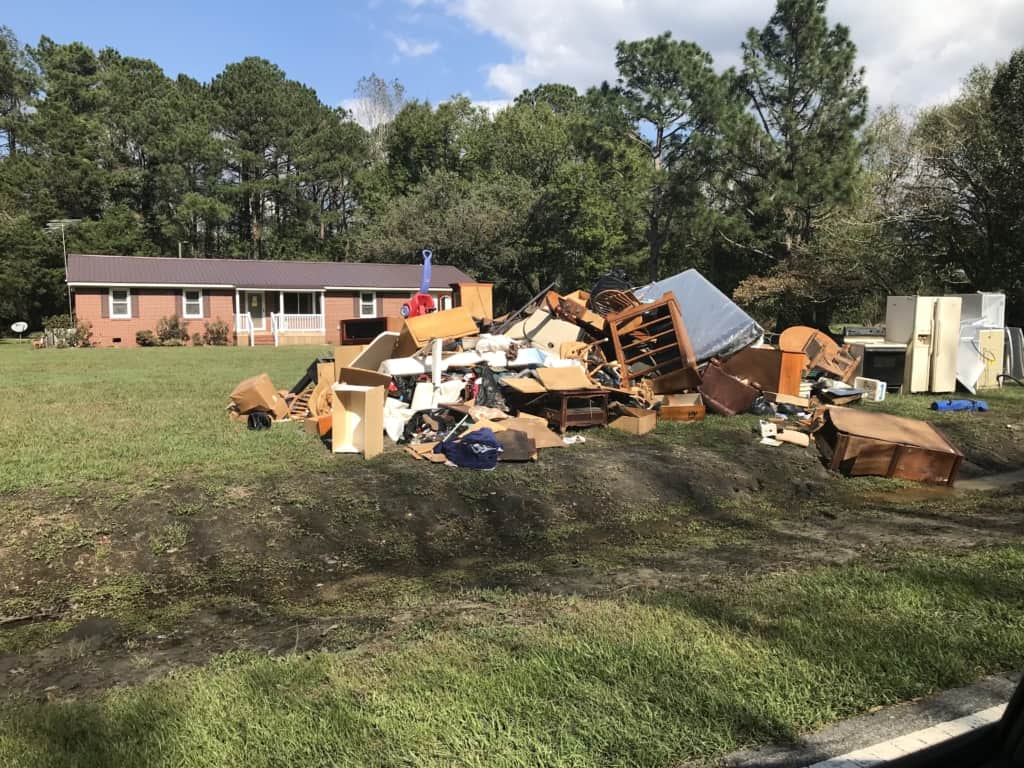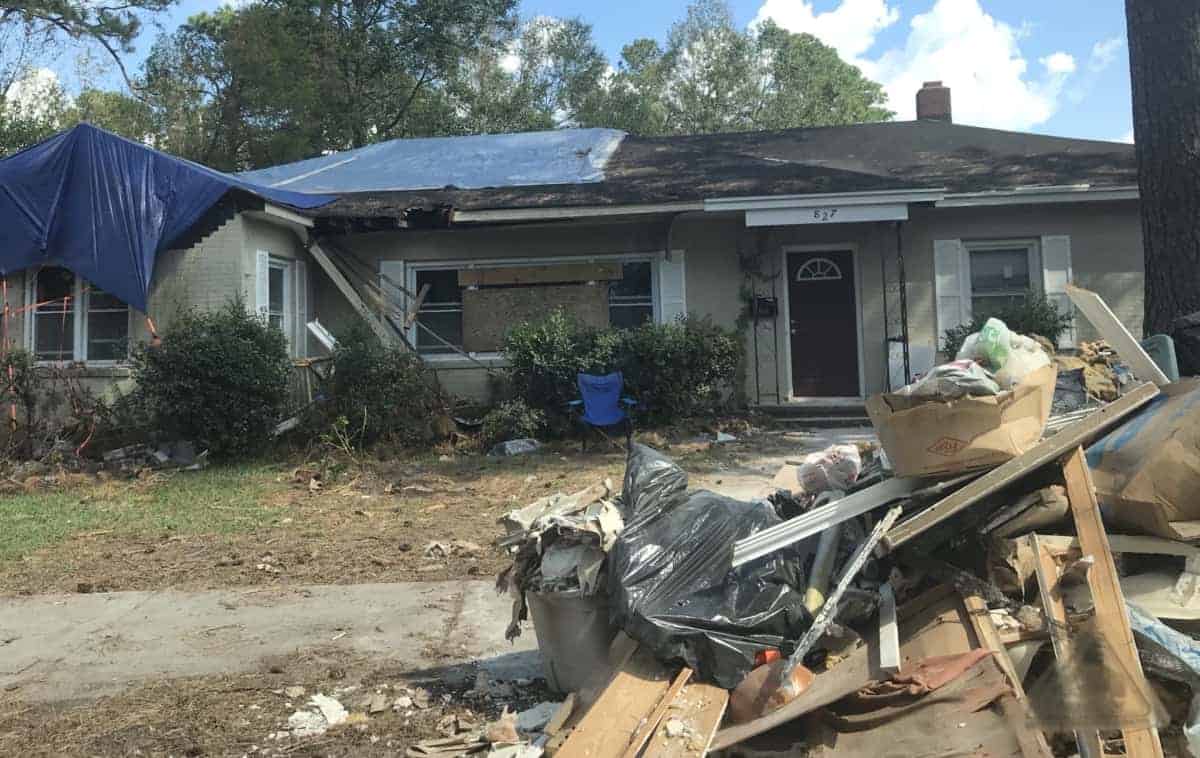Three months have passed since Hurricane Florence made landfall in the southeastern part of North Carolina. The waters have subsided and much of the debris has been cleared. A drive through most of the main streets of the region reveal little of the impact Florence made.
But the reminders are scattered about. You see them at town dumps, heaping with discarded furniture and memories. You see them in the tree stumps, and other remains from the millions of bushes and shrubs felled before they even had a chance to turn colors for the fall.
And reminders remain on the faces of the people. Those survivors still wondering what happened while they work out what to do next. The astonishment and shock, and sheer sadness, spills with the tears from their eyes when they recall what happened. And what lies ahead.
“I still can’t talk about it without — I’m crying now,” said Christy Strickland, wiping tears from her eyes as she thinks back on first seeing her flood-ravaged home, where she still cannot live. “You wake up some days and — I mean, everyday you’re glad that you’re here and that you made it through, and it could have been worse. But you wake up some days, and it’s just hard.”
North Carolinians put 2018 to bed last night and woke up to a new year. But for thousands along the coast of our state, 2019 will be full of the reminders from a most trying event — and full of work left to be done to completely put the trials behind them.
At one point, Hurricane Florence was a Category 4 storm as wide the entire state. Winds peaked at 140 mph, but winds paled in comparison to the rain. Florence hovered over North Carolina for six days, dumping higher levels of rainfall, and causing more storm surge, then any storm in recent memory.
The numbers are staggering, with 40 confirmed fatalities in North Carolina, property damage, and power outages to more than a million people, and the displacement of tens of thousands of families from their homes. It is estimated that Florence caused $17 billion in damage across 44 counties — where 40 percent of the state’s population live.
For perspective, this estimate means damage from Florence is far greater than the damage from North Carolina’s two previous hurricane disasters combined (when adjusted for inflation, the damage estimate for Hurricane Matthew was $4.8 billion and Hurricane Floyd was between $7 and $9.4 billion).
And much of this was borne by a handful of counties in the southeastern bend along the coast. They’re rebuilding their lives and their communities. And they’re doing it while Mother Nature presses on.
“We’re in recovery mode,” said Tammy Procter, public information officer for Pender County. “It’s just a long recovery. And right now, we’ve had two weekends of rain, and we’re going to have more rain this week. The rivers are rising again. It’s just a recovery process. It’s a major project.”
The numbers tell a harrowing story, but they fall short of conveying the real impact. That work is left for the survivors, whose strength is admirable if not ever-present. Their hope as the calendar year changes is that the rest of the state — and country — won’t forget about them after making their New Year’s resolutions.
A retired teacher and her student
Jennie Kennel Adams taught at Arapahoe Charter School for thirteen years, after stints at middle and high schools in Wake and Pamlico Counties. Now retired and living near Arapahoe, she sees former students often.
Two weeks ago, she sat next to a former student, Christy Strickland, as they listened to Pamlico County officials discuss hurricane relief efforts. The pair listen to the numbers County Manager Tim Buck rattles off, but they don’t need numbers for this to feel real. Both of them were impacted — and they sit by each other as they think about what to do next.
“You have to put her middle name, Dixon,” Adams says as they settle in for an interview. “That’s how I knew her, Christy Dixon. She was a great volleyball player.”
It’s a light moment before they recount their experiences during and after Florence.

Adams couldn’t convince her husband to leave ahead of Hurricane Florence. The retired Pamlico County teacher took two of the couple’s four dogs and drove to Raleigh. Her husband stayed behind and took a two-hour nap. When he woke up, there was already six inches of water in the house.
“He had to stay up there for two days with two of our dogs,” Adams said. “He had peanut butter and dog food. That was it. He couldn’t get out because he just didn’t calculate his time well.”
Strickland lives nearby to Adams. There was never a question whether she was going to leave ahead of Florence. She watched the devastation unfold on television and the Internet.
“I saw pictures on Facebook — from relatives, because we live in a community where we’re all related,” she said. “So I saw pictures on Facebook on Thursday that it was already going in my house.”
She returned to a home that had taken on nearly three feet of water. It took three days before the water could go down, and she could get back in.
“It was devastating,” she said. “We had furniture that was literally picked up and moved. You wouldn’t believe it.”
For Adams and Strickland, the shock of seeing their homes flooded wasn’t even the hardest part.
“Three days after, I had furniture that had mold growing already,” Adams said. “We had to get it out. I threw away things of my family’s that I would never have thrown away.”
It’s the memories embedded in the furniture and pictures and heirlooms lost that have a staying effect.
“I think one of the hardest things is what we couldn’t anticipate,” Strickland said. “We never flooded — so even in preparation, I didn’t think to prepare for the pictures and things that were” — she points down as if to a bottom drawer of an end table — “down there. Those are the things that you don’t think about, because I never thought the water was coming into my house.”
A most pressing need
That was the immediate impact of Hurricane Florence. Coping with the sight of flooded homes and lost personal items. But the challenges didn’t subside with the water.
For one thing, while much of the debris is gone, some still remains. And it’s the most heart-wrenching type.
“It is still hard to drive down some of these roads and see the devastation,” Procter said. “You see people’s belongings out on the side of the road. It’s still hard to see that.”

These are remnants from what short-term recovery looked like: massive efforts to muck-and-gut homes, removing furniture, dry wall and insulation that came into contact with toxic flood waters.
Long-term recovery looks like rebuilding those houses, or scrapping them altogether when they are unsalvageable or built in high-risk areas, and finding a way to get people back into homes.
“It’s a tough, tough thing to go through,” Buck said. “It’s a personal thing. Their lives are interrupted. Some of them might not have a place to stay. Some may not be able to get back in their house immediately. Some may not be able to get back in their house at all until they find a way to get it repaired. It’s a tough situation. Hopefully, we’ll be able to help as many people up-and-going as we can.”
According to Governor Cooper’s office, there were three primary areas of impact that drive 80 percent of the direct and indirect damage estimates: businesses, housing, and agriculture. More than 3,2800 private-sector businesses incurred water damage and more than 23,000 sustained wind damage — with current damage estimates at $5.7 billion. The storm also caused substantial damage to crops, livestock and farm buildings, equipment and infrastructure losses — to the tune of more than $2.4 billion.
But it’s the housing that seems most pressing. Eastern North Carolina was already experiencing a housing shortage. Now, something like 30 percent of North Carolina households were affected by the storm with a preliminary damage estimate of $5.6 billion and rising.
“People still need a place to live,” said Kate Murphy, who is communications outreach coordinator for emergency management and recovery in New Hanover County.
“And something we know about natural disasters is that they exacerbate the issues you already had. Housing was high-priced and hard to come by before Hurricane Florence. Now we have a decrease in housing units available with an increase in the number of individuals who need those units.”
Houses were gutted and condemned. Entire apartment buildings were shut down — some temporarily, some permanently. Residents face thousands of dollars in repairs, some with mandates to elevate their properties — a prospect that carries with it a five-figure price tag.
While Adams couch surfed with neighbors, Strickland and her family found refuge in one place — but it’s a difficult situation with her mother, herself, her husband, two kids, and all of their animals living under one roof with her mother’s boyfriend.
“It’s hard just to find a place to stay,” Strickland said.
The balancing act
While communities and their residents work on rebuilding homes, they are walking a line between calls for help and being able to strengthen their economy and earn dollars to rebuild from within.
For these communities, recovery looks like help from the government, help from volunteers, and help from community organizations, as we’ll explore further tomorrow. But it also looks like getting back on their feet and restoring business, which is harder than it sounds for coastal counties whose economy depends on tourism dollars.
“We’re struggling in that, here we come after the holidays and we’re trying to bring visitors back,” Procter said. “We’re rebuilding the beach access, you can go out on the beach. Our new bridge just opened to Topsail Island. So we want to bring people back, and those images of floods and people living in tents — that’s still alive in their minds. We have this balance that we have to strike that, yes, we’re still rebuilding, but we’re still a destination for people to book their vacations.”
In some parts of New Hanover County, the roads were surrounded by piles of vegetative debris stacked eight- or 10-feet high. Beth Schroeder, chief strategy officer for New Hanover, recalled it was like driving in the spooky forest. Removal of the debris — and the county estimates it has removed more than 1.2 million cubic feet of vegetative debris the past three months — was a step toward normalcy and inviting tourists back into the communities.
“We’re open for business in anyway you can put that phrase,” Murphy said. “We’ve worked hard to make sure that families outside of New Hanover County and the coastal area know that, when they’re making their holiday travel plans, that we’re still a destination and they can visit our area. That’s an important part of our recovery because it is such an important part of our economy here.”



